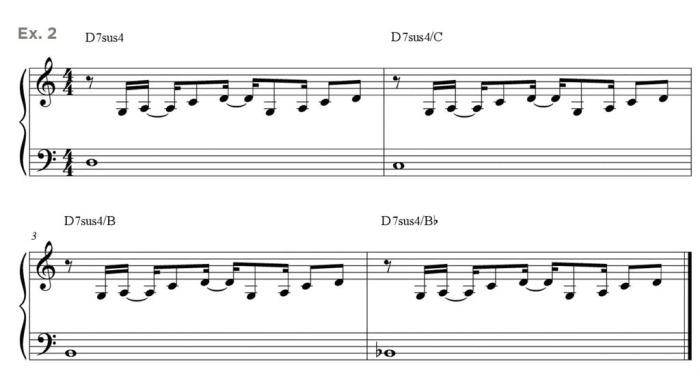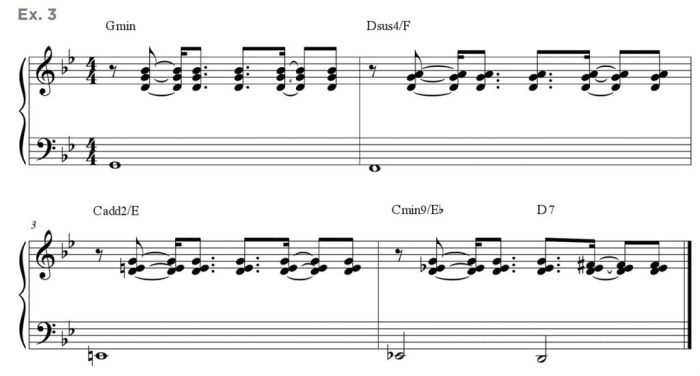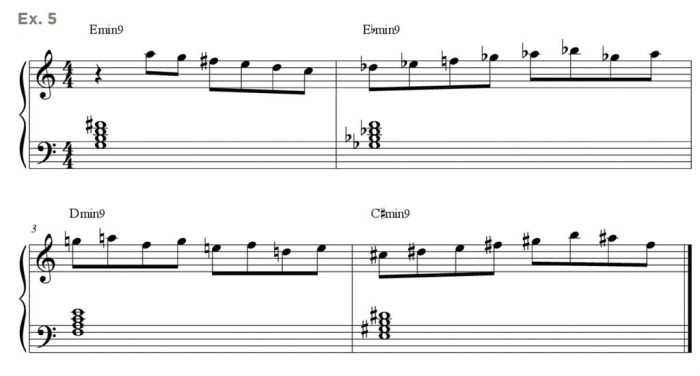5 ways to play jazz piano like Robert Glasper
As he prepares to release his Black Radio 3 album, we analyse the playing of the Grammy-winning artist

Hailing from Houston, Texas, jazz pianist and composer Robert Glasper burst onto the music scene in 2005 and was quickly signed to Blue Note Records.
His Robert Glasper Experiment albums Black Radio and Black Radio 2 albums, marrying jazz, hip-hop and groove-oriented music, both won Grammy Awards.
With Black Radio 3 set for release on 25 February, let’s delve into Glasper’s unique style.
1. Pedal points
Ex. 1 is influenced by Glasper’s work on his cover of the Joni Mitchell song Barangrill. In the intro, Glasper plays tender melodies over a pedal point that goes from major to minor tonalities.
In this example and over an F pedal in the bass, we have a root position Eb major seventh chord in the left hand. This creates a tidy F7sus4 voicing when played against the pedal note. The tonality changes to an F minor seventh chord in root position in bars 3 and 4.
In the right hand, we see notes from the corresponding scales; over the F7sus4 we use a few notes from the F Mixolydian mode (F, G, A, Bb, C, D, Eb, F). In Bars 3 and 4 we use notes from the F Dorian mode (F, G, Ab, Bb, C, D, Eb, F).

2. Ostinatos and descending bass
In Ex. 2, we see a right-hand ostinato that repeats over a descending bassline, another technique often used by Glasper. Notice that all of the notes in the right hand come from the D Dorian mode (D, E, F, G, A, B, C, D).
Get the MusicRadar Newsletter
Want all the hottest music and gear news, reviews, deals, features and more, direct to your inbox? Sign up here.
Under this line full of syncopated 16th-note subdivisions, a simple whole-note bassline descends. In the last bar, the bass note moves to a note outside of the mode, Bb. The notes against this bass create a Bb major 13 arpeggio.

3. Moving triads
Ex. 3 illustrates Glasper’s use of syncopated chords also moving over a descending bassline.
Here we are in the tonality of G minor, with a bassline that moves down the G Dorian mode (G, A, Bb, C, D, E, F, G) until it goes to a flatted sixth (Eb) and arrives at the fifth (D).
Note that, while bar 1 begins with a G minor triad in the right hand, the rest of the right hand chords are all suspended triads such as bar 2’s Dsus, bar 3’s C9 and bar 4’s Cmin9.

4. The sound of seconds
In Ex. 4, we investigate voicings built with the 'crunchy' interval of a second. In the first two bars, the lowest two notes of the right hand are made up of second intervals, which create a pleasing crunch that the remaining thirds sit atop to form nicely balanced jazz voicings.
Bar 3 has a stock Amin9 voicing with the addition of the note D for a minor 11th sound. This sound imparted by the second interval adds spice to what might be considered an old-fashioned jazz chord.
The last bar has the second near the top of the voicing.

5. Eighth notes and minor ninths
Ex. 5 pairs eighth-note lines with descending minor ninth chords, inspired by Glasper’s solo on the venerable jazz standard Stella by Starlight. Note that in the left hand, we are using minor ninth voicings that descend by half steps. The right hand lines are taken right from the respective Dorian mode with the exception of a few chromatic notes.

Practice tip
“Try transposing these exercises through all 12 keys and notice how your jazz vocabulary skyrockets,” says keyboardist and composer Brian Charette, who has performed and recorded with artists including Joni Mitchell, Michael Bublé, and Rufus Wainwright, in addition to leading his own jazz groups.
MusicRadar deals of the week: Enjoy a mind-blowing $600 off a full-fat Gibson Les Paul, £500 off Kirk Hammett's Epiphone Greeny, and so much more
“For those who think they know Joel’s story, as well as those who are not as familiar, I believe this two-part film is both a revelation and a surprise”: New Billy Joel doc is on the way









